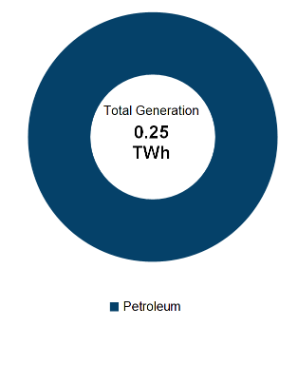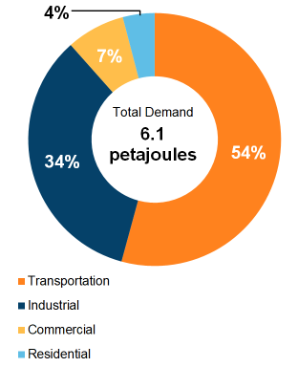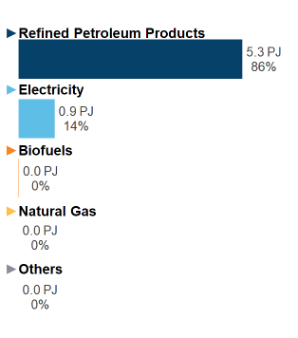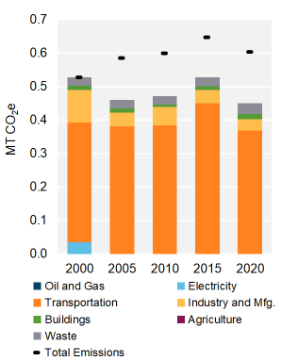Provincial and Territorial Energy Profiles – Nunavut
Update in progress
An update to these profiles will launch in Summer 2024. For current data and information, please visit:
- Canada's Energy Future data appendices tool
- Environment and Climate Change Canada's GHG Emissions Inventory

Connect/Contact Us
Please send comments, questions, or suggestions to
energy-energie@cer-rec.gc.ca
Table of Contents
-
Figure 1: Electricity Generation by Fuel Type (2019)
Source and Description:
Source:
CER – Canada's Energy Future 2021 Data AppendicesDescription:
This pie chart shows electricity generation by source in Nunavut. A total of 0.25 TW.h of electricity was generated in 2019. -
Figure 2: End-Use Demand by Sector (2019)
Source and Description:
Source:
CER – Canada's Energy Future 2021 Data AppendicesDescription:
This pie chart shows end-use energy demand in Nunavut by sector. Total end-use energy demand was 6.1 PJ in 2018. The largest sector was transportation at 54% of total demand, followed by industrial (at 34%), residential (at 7%), and lastly, commercial (at 4%). -
Figure 3: End-Use Demand by Fuel (2019)
Source and Description:
Source:
CER – Canada's Energy Future 2021 Data AppendicesDescription:
This figure shows end-use demand by fuel type in Nunavut in 2018. Refined petroleum products accounted for 5.3 PJ (86%) of demand, followed by electricity at 0.9 PJ (14%). There was no end-use demand of biofuels, natural gas, or others.
Note: "Other" includes coal, coke, and coke oven gas. -
Figure 4: GHG Emissions by Sector
Source and Description:
Source:
Environment and Climate Change Canada – National Inventory ReportDescription:
This stacked column graph shows GHG emissions in Nunavut by sector every five years from 1990 to 2020 in MT of CO2e. Total GHG emissions have increased in Nunavut from 0.53 MT of CO2e in 2000 to 0.60 MT of CO2e in 2020. -
Figure 5: Emissions Intensity from Electricity Generation
Source and Description:
Source:
Environment and Climate Change Canada – National Inventory ReportDescription:
This column graph shows the emissions intensity of electricity generation in Nunavut from 1990 to 2020. In 1990, electricity generated in Nunavut emitted 880 g of CO2e per kWh. By 2020, emissions intensity decreased to 800 g of CO2e per kWh.
Energy Production
Crude Oil
- Nunavut does not have any commercial crude oil production.
- Between 1985 and 1996, approximately 3.0 million barrels of crude oil were produced at the Bent Horn field on Cameron Island. The light crude oil produced at Bent Horn was used to power generators at Resolute Bay and the Polaris Zinc Mine.
- In December 2016, the federal government announced that Canadian Arctic offshore, including the federal waters offshore of Nunavut, is indefinitely off limits to new offshore oil and gas licensing, to be reviewed every five years. The first five-year review was due in 2021, but the science-based review work was delayed until 2022. The federal government, Inuvialuit Regional Corporation, Nunavut Tunngavik Incorporated, and the governments of Yukon, the Northwest Territories, and Nunavut are developing assessments to be reviewed in 2022.
- In 2019, the federal government issued an order, expiring at the end of 2021, prohibiting all oil and gas activities in the Canadian Arctic offshore, including activities associated with existing licenses. This order was amended on 21 December 2021 to extend it until 31 December 2022, to accommodate the completion of the scientific reviews. Also in 2019, the government announced that it will freeze the terms of existing licenses in the Arctic offshore to preserve existing rights.
- The federal government returned $430 million in security deposits to oil and gas companies that had existing licenses. After 31 December 2021, offshore licence holders will have the option to pay the license deposit again or surrender the licence.
- In preparation for the 2021 review, the Nunavut Impact Review Board completed an assessment of oil and gas development in Baffin Bay and Davis Strait.
- Discussions regarding the review are ongoing between the provincial governments of Nunavut, the Northwest Territories, Yukon, federal government, and northern Indigenous communities.
- Nunavut’s crude oil resources are estimated at 18.3 billion barrels.
Refined Petroleum Products (RPPs)
- There are no refineries in Nunavut.
Natural Gas/Natural Gas Liquids (NGLs)
- There is currently no natural gas or NGL production in Nunavut.
- Nunavut’s natural gas resources are estimated to be 181.4 trillion cubic feet.
Electricity
- In 2019, Nunavut generated around 0.25 terawatt-hours (TWh) of electricity (Figure 1), which is less than 0.05% of total Canadian production. Nunavut has an estimated generating capacity of 54 megawatts (MW).
- Qulliq Energy Corporation (QEC), owned by the Nunavut government, is responsible for generation, transmission, and distribution of electricity in Nunavut. QEC operates 25 diesel plants in 25 communities. These communities are not connected by roads or power lines and there is no back-up grid.
- Almost all of Nunavut’s electricity is generated from diesel fuel imported during the summer and then stored for year-round use.
- In January 2019, QEC completed construction and testing of new diesel power plants at Grise Fiord and Cape Dorset. These diesel plants replaced older, less efficient models and have the capability of integrating renewable energy sources. In November 2019, QEC submitted a plan to the territorial government to replace older diesel generators in Arctic Bay with more efficient models, add a fourth generator for expanded capacity, and ability to integrate renewable sources.
- In August 2019, the Canadian government, QEC, and the Mayor of Kugluktuk announced joint funding for Nunavut’s first hybrid solar/diesel power plant, replacing the existing less efficient diesel facility built in the late 1960s. The project will include a 500 kilowatt (kW) solar system. Construction of the plant has been delayed due to COVID-19, and completion of the project is now expected in late 2023.
- Solar panels have been installed at the QEC’s power plant in Iqaluit since March 2016, as part of a pilot project. Solar panels have also been installed at the Arctic Winter Games Arena and Arctic College, both in Iqaluit.
- QEC’s Net Metering Program allows residential and municipal electricity customers to produce their own electricity through small-scale (up to 10 kW) renewable energy sources, and integrate their surplus energy to QEC’s local grid in exchange for credits for future electricity use.
Energy Transportation and Trade
Crude Oil and Liquids
- There are no crude oil pipelines or crude-by-rail facilities in Nunavut.
- RPPs, including gasoline, diesel, and jet fuel, are received from neighbouring provinces and territories by truck and small marine vessels. RPPs are distributed throughout the territory in the summer when the roads and waterways are accessible.
- Nunavut’s harsh climate, sparse population, small community sizes, and large distance from refining centres results in costly product delivery. The territorial government’s Petroleum Products Division is responsible for the supply, distribution, and delivery of fuel products using private companies or subcontractors.
Natural Gas
- There are no natural gas pipelines in Nunavut.
Liquefied Natural Gas (LNG)
- There are no current or proposed large-scale LNG facilities in Nunavut.
Electricity
- There are no regional or territorial electricity grids in Nunavut. All electricity generation is community based.
- As a result of long distances to neighbouring provinces and territories, there are no transmission lines to enable the trade of electricity between Nunavut and other jurisdictions.
- The federal government is supporting studies on the feasibility of the proposed Kivalliq Hydro-Fibre Link Project. The project includes a transmission power line and broadband internet connection from northern Manitoba to communities in Nunavut.
Energy Consumption and Greenhouse Gas (GHG) Emissions
Total Energy Consumption
- End-use demand in Nunavut was 5.8 petajoules (PJ) in 2019. The largest sector for energy demand was transportation at 55% of total demand, followed by industrial at 33%, commercial at 8%, and residential at 4% (Figure 2). Nunavut’s total energy demand was the smallest in Canada, and smallest on a per capita basis.
- RPPs were the largest fuel-type consumed in Nunavut in 2019, accounting for 5 PJ, or 85%. Electricity accounted for the remaining 0.8 PJ (14%) (Figure 3).
Refined Petroleum Products
- Nunavut is the smallest market in Canada for RPPs. Total 2019 demand for RPPs was less than 0.1% of total Canadian RPP demand.
- A breakdown of RPP demand by motor gasoline and diesel is not available for Nunavut.
- A significant portion of Nunavut’s demand for diesel fuel is for power generation. Virtually all of Nunavut’s installed electricity generation capacity is diesel-fueled.
- Gasoline and diesel (for vehicle use and heating) prices are set by the territorial government on an annual basis and are matched by each region. The prices across Nunavut are $1.099 per litre for gasoline and $1.196 per litre for vehicle diesel, effective April 2021.
Natural Gas
- No natural gas is used in Nunavut.
Electricity
- In 2019, annual electricity consumption per capita in Nunavut was 6.1 megawatt-hours (MWh). Nunavut ranked the lowest in Canada for per capita electricity consumption and consumed 60% less than the national average.
- Nunavut’s largest consuming sector for electricity in 2019 was commercial, at 0.11 TWh, followed by the residential sector at 0.07 TWh.
- Nunavut has one of the highest electricity rates in Canada because of low population density and high fuel imports. Residential electricity rates are generally subsidized, up to a monthly usage threshold, to equalize rates across the territory. There is also a public housing subsidy for customers on income assistance.
GHG Emissions
- Nunavut’s GHG emissions in 2020 were 603 thousand tonnes of carbon dioxide equivalent (CO2e).Footnote 1 Nunavut’s GHG emissions have increased 3% since 2005.
- Nunavut’s emissions per capita are 15.4 tonnes CO2e – 13% below the Canadian average of 17.7 tonnes per capita.
- The largest emitting sector in Nunavut is transportation at 61% of emissions (Figure 4).
- In 2020, Nunavut’s power sector emitted 150 thousand tonnes CO2e emissions, which represents about 0.3% of Canadian emissions from power generation.
- The greenhouse gas intensity of electricity generation in Nunavut, measured as the GHGs emitted in the generation of electricity in the territory, was 800 grams of CO2e per kilowatt-hour (g of CO2e/kWh) electricity generated in 2020. The national average in 2020 was 110 g of CO2e/kWh (Figure 5).
More Information
- Government of Nunavut–Fuel Prices for 2021
- Nunavut Energy Management Program
- Qulliq Energy Corporation
- Nunavut's Energy System: Nunavut Climate Change Centre
- CER–Canada’s Renewable Power: Nunavut
- CER–Market Snapshot: Overcoming the challenges of powering Canada’s off-grid communities
- CER–Market Snapshot: Explaining the high cost of power in northern Canada
Data Sources
Provincial & Territorial Energy Profiles aligns with the CER’s latest Canada's Energy Future 2021 Data Appendices datasets. Energy Futures uses a variety of data sources, generally starting with Statistics Canada data as the foundation, and making adjustments to ensure consistency across all provinces and territories.
- Date modified:





